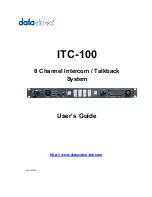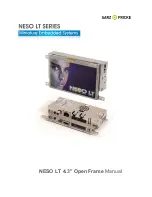
Technical Guide |
Digital & Analog Partyline Intercom Cabling Comparison
Nov2018
Page 4
In this extreme case, assume the audio signal is 20 KHz
and the cable attenuation at 20 KHz is the same as at
1MHz (In reality it will be much lower, but cable
manufacturers do not specify cable attenuation at such
low frequencies). There will be attenuation (see Figure
4) of around 30dB/Km so with our maximum allowable
cable length the audio level will be reduced by:
𝑚𝑚𝐴𝐴𝐴𝐴𝐴𝐴𝐴𝐴𝐴𝐴𝐷𝐷𝐴𝐴𝐴𝐴𝐴𝐴𝐴𝐴
= 0.6
𝐾𝐾𝐷𝐷
𝐷𝐷
30
𝑑𝑑𝑑𝑑
𝐾𝐾𝐷𝐷
= 18
𝑑𝑑𝑑𝑑
Digital Partyline
In Clear-Com’s digital partyline system, higher
frequencies are used to transmit digitized audio and
control data than are used in analog partyline systems.
The maximum frequency used for transmission is around
25MHz.
At that frequency, cable attenuation increases but the
nature of the transmission and reception technology used
means that the system can operate with much greater
levels of signal attenuation without loss of data.
Figure 6 Clear-Com Digital Partyline Maximum
Bandwidth vs Attenuation
Figure 6 shows us that depending on the amount of data
transmitted, Clear-Com’s digital partyline system can
operate with as much as 90dB of attenuation between
nodes.
It should be noted that this ability to receive highly
attenuated signals increases the possibility of crosstalk
between cables. It is therefore important to maintain
cable shield integrity through all connectors, splitter
boxes and patch panels.
Each unit connected to a digital partyline requires a
certain amount of bandwidth available on the line in order
to operate. Clear-Com’s digital partyline products each
require the following bandwidth:
Description
Model # Bandwidth (Mbps)
HelixNet Beltpack
HBP-2X 1.8
HelixNet Beltpack
HBP-2XS 1.8
HelixNet Speaker Station HKB-2X
1.8
HelixNet Remote Station HRM-4X 3.1
Table 1 Clear-Com Digital Partyline Unit Bandwidth
Requirements
Figure 7 Bandwidth Required vs Number of Units
Figure 7 shows the bandwidth required on a Clear-Com
digital partyline for differing numbers of digital partyline
units.
Take our previous digital partyline example:
BELTPACK 10
BELTPACK 2
MASTER
STATION
BELTPACK 1
12.3
Ω
12.3
Ω
1.46A
60V
DC
OUT
24V
DC
MIN
0.36Km
Belden 9463F
Figure 8 Ten Beltpack Digital Partyline Example
This system, with .36Km of cable with attenuation (from
Figure 4) of around 130dB/Km will have an attenuation
of:
𝑚𝑚𝐴𝐴𝐴𝐴𝐴𝐴𝐴𝐴𝐴𝐴𝐷𝐷𝐴𝐴𝐴𝐴𝐴𝐴𝐴𝐴
= 0.36
𝐾𝐾𝐷𝐷
𝐷𝐷
130
𝑑𝑑𝑑𝑑
𝐾𝐾𝐷𝐷
= 48
𝑑𝑑𝑑𝑑
From Table 1 we can calculate that these 10 beltpacks
will require:
𝑑𝑑𝐷𝐷𝐴𝐴𝑑𝑑𝐵𝐵𝐴𝐴𝑑𝑑𝐴𝐴ℎ
= 1.8
𝑀𝑀𝑀𝑀𝑀𝑀𝑀𝑀
𝐷𝐷
10 = 18
𝑀𝑀𝑀𝑀𝑀𝑀𝑀𝑀
From Figure 6 we can see that with 18Mbps of bandwidth
required, the system will operate with attenuation up to
90dB. Our calculated attenuation for this example of
48dB above is well below that limit.
The nature of Clear-Com’s digital partyline system means
that when it reaches its maximum cable length for data
attenuation, the user will begin to experience lost audio
packets. When the maximum cable is exceeded by a
significant amount, units will fail to connect to their main
station. The units all provide a signal level meter on their
display indicating the quality of connection back to their
main station helping a system installer to see when they
are approaching the system’s limits.
0
20
40
60
80
100
120
0 10 20 30 40 43 46 60 70 76 79 82 85 90
M
axi
m
u
m
P
o
ssi
b
le
D
a
ta
B
a
n
d
w
id
th
(M
b
p
s
)
Cable Attenuation (dB)
Acceptable
Unacceptable
0
20
40
60
80
100
1
11
21
31
41
51
Ba
nd
w
id
th
R
eq
ui
re
d
(M
bp
s)
# of Units
HRM-4X Bandwidth
HBP-2X/HKB-2X Bandwidth























